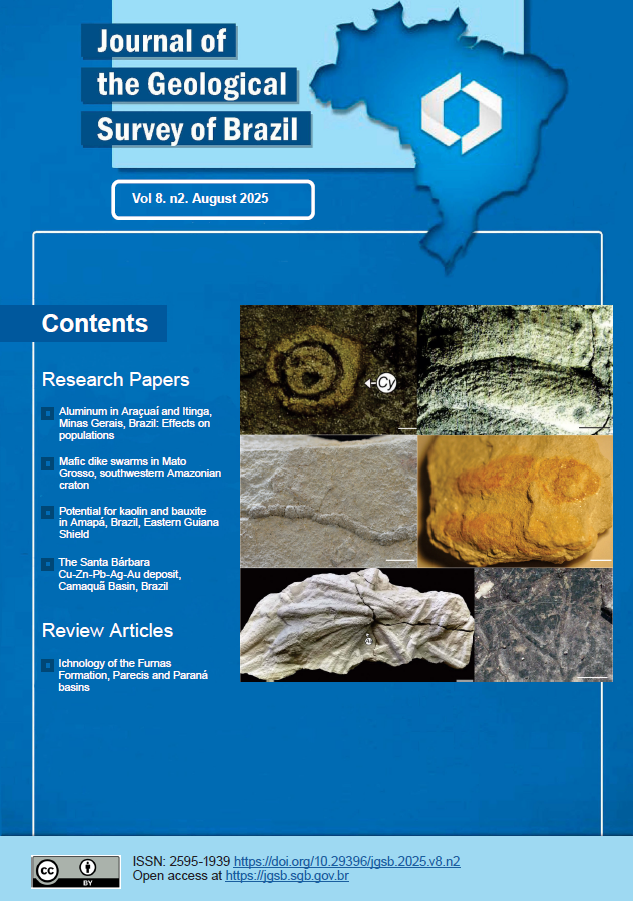Geochemical and tectonic setting of mafic dike swarms of the Juruena-Teles Pires mineral province, southwestern Amazonian craton, Brazil
Main Article Content
Abstract
The present study provides a comprehensive set of whole-rock geochemical, petrographic, and mineral chemistry data on diabase dike swarms that crosscut the Archean/Paleoproterozoic basement of the Peixoto de Azevedo domain, located in the central-western part of the Juruena-Teles Pires mineral province, in the southwestern portion of the Amazonian Craton. The dike swarms are classified into two groups based on TiO₂ concentration: high-Ti (HTi, >2 wt.%) and low-Ti (LTi, <2 wt.%). In the Peixoto de Azevedo domain, LTi dikes, with an undetermined crystallization age, predominantly exhibit N30-40E strikes. In contrast, in the central-western Juruena-Teles Pires province, the ~1.8 Ga fissure-controlled HTi dikes are systematically aligned along shear zones and fault systems, with strikes varying from E-W to WNW-ESE, predominantly crosscutting Orosirian/Statherian granitic rocks. Mineral assemblages in LTi dikes are dominated by clinopyroxene (augite) and plagioclase, the latter sometimes exhibiting a Ca-rich core (An63-74) and a Na-enriched rim (An26-43), with minor Fe-Ti oxides, apatite, and biotite. Conversely, HTi dikes contain labradorite, augite (±olivine), magnetite, and ilmenite, with common accessory minerals such as biotite and apatite. Both groups exhibit low Ni contents, which, in conjunction with the observed CaO-MgO correlations, indicate fractional crystallization likely controlled by plagioclase and clinopyroxene. The HTi and LTi dikes are tholeiitic and classified as continental flood basalts, displaying distinct geochemical features. LTi dikes have Mg# values ranging from 0.32 to 0.58 and are enriched in Ba, K, Rb, Sr, Ce, and Y, with low to moderate MgO, Ni, and Cr contents, and moderate LREE enrichment. In contrast, HTi dikes have relatively low Mg# (31–49) and are slightly more evolved than the LTi diabase dikes. Additionally, they exhibit higher concentrations of TiO₂, P₂O₅, Ba, Rb, Sr, Th, Ce, Y, Zr, as well as both LREE and HREE. The relationship between typical crustal elements in the chemical composition of the studied diabases, such as Ba, Rb, La, Ce, and Nb-Ta, supports the presence of a crustal component in the source of both HTi and LTi dikes. These geochemical characteristics suggest that crustal contamination and fractional crystallization may have influenced their magmatic evolution. The probable occurrence of lithospheric delamination, accompanied by crustal thinning and mantle uplift followed by mantle melting, likely culminated in the generation of intraplate continental tholeiitic magmatism, often marking significant geodynamic events in the southwestern portion of the Amazonian craton.
Article Details

This work is licensed under a Creative Commons Attribution 4.0 International License.
The papers are published in the open access format, being freely available to any user, under a CC-BY Creative Commons license.
By submitting this manuscript for evaluation, the authors are aware of the CC-BY Creative Commons license. In the case of manuscript approval, the author responsible for the manuscript (corresponding author), hereinafter referred to as CEDENTE (ASSIGNOR), hereby assigns and transfers to CPRM-Serviço Geológico do Brasil, holder of the JGSB, free of charge, on his behalf and on behalf from all co-authors, the right of the first publication. This includes the rights of editing, publication, translation into another language and reproduction by any process, worldwide, today and in the future.
After the first publication by the JGSB, authors hold the copyright without restrictions and are allowed to disclose and distribute their work through personal website pages and institutional repositories.
At the same time, the ASSIGNOR declares that the content of the manuscript is of sole responsibility of the authors and that this content does not infringe the copyrights and/or other property rights of third parties, that is, that any contents of the manuscript and its attachments, if taken from other publications, are duly referenced and, when necessary, the permissions for publications of such contents were requested by the authors from the copyright holders; that the disclosure of images (if any) has been authorized and that it assumes full moral and/or patrimonial responsibility, due to its content, before third parties.





